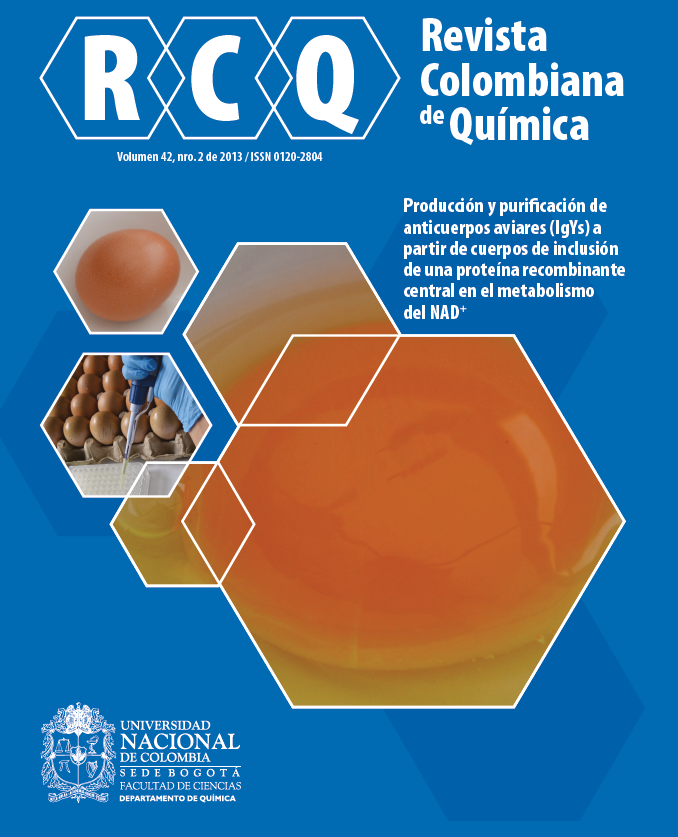Estudio de la capacidad antioxidante del arazá (Eugenia stipitata Mc Vaugh) durante la maduración
Research of antioxidant capacity of araza (Eugenia stipitata Mc Vaugh) during the ripening
Palabras clave:
Arazá, capacidad antioxidante, ABTS, DPPH, FRAP, decoloración del β-caroteno, madurez (es)Araza, antioxidant capacity, ABTS, DPPH, FRAP, β-carotene bleaching, ripening (en)
Descargas
The araza is a fruit native of the Amazon region, like other fruits of this region has some antioxidant components. This work was carried out the classification of the fruits of araza in four different states using as the index of maturity, then phenolic compounds were extracted using mixtures of solvents (methanol, acetone, water) and your content was determined by the spectrophotometric method Folin-Ciocalteu in the epicarp and mesocarp. Additionally, partially identified phenolic compounds by reversed phase HPLC with diode array, finding the phenolic acids such as chlorogenic, gallic and caffeic, such as phenols responsible for the majority of araza antioxidant activity. It was noted that araza mesocarp polyphenol content was higher in the green (1200 mg/1000g fruto BH) state followed by mature (1200 mg/1000g fruto BH), pinton (905 mg/1000g fruto BH) and over mature (550 mg/1000g fruto BH) while the epicarp was greater in states mature (170 mg/1000g fruto BH) and green (295 mg/1000g fruto BH) followed of the over-mature (50 mg/1000g fruto BH) and pinton (100 mg/1000g fruto BH) states. The antioxidant capacity was determined by three hydrophilic methods (ABTS, DPPH and FRAP) in the mesocarp found that the antioxidant capacity was higher in the green state followed by mature), pinton and over mature while the epicarp was higher in mature, green, pinton) and over-mature state. We also determined the antioxidant capacity by a lipophilic method (b-carotene bleaching) found that in the mesocarp was higher in states followed by mature (110 mg/1000g fruto BH), pinton (90 mg/1000g fruto BH) and green (26 mg/1000g fruto BH) while in the epicarp was higher in the over mature stage (50 mg/1000g fruto BH)followed by greeen states (45 mg/1000g fruto BH), mature (55 mg/1000g fruto BH)and sobre mature (25 mg/1000g fruto BH). Finally we conclude that the mature and green had the highest antioxidant capacity, phenolic compounds being present in the epicarp and mesocarp were the major contributors.
Cómo citar
IEEE
ACM
ACS
APA
ABNT
Chicago
Harvard
MLA
Turabian
Vancouver
Descargar cita
Visitas a la página del resumen del artículo
Descargas
Licencia
Los autores/as conservarán sus derechos de autor y garantizarán a la revista el derecho de primera publicación de su obra, el cuál estará simultáneamente sujeto a la Licencia de reconocimiento de Creative Commons (CC. Atribución 4.0) que permite a terceros compartir la obra siempre que se indique su autor y su primera publicación en esta revista.
Los autores/as podrán adoptar otros acuerdos de licencia no exclusiva de distribución de la versión de la obra publicada (p. ej.: depositarla en un archivo telemático institucional o publicarla en un volumen monográfico) siempre que se indique la publicación inicial en esta revista.
Se permite y recomienda a los autores/as difundir su obra a través de Internet (p. ej.: en archivos telemáticos institucionales o en su página web) antes y durante el proceso de envío, lo cual puede producir intercambios interesantes y aumentar las citas de la obra publicada. (Véase El efecto del acceso abierto).













